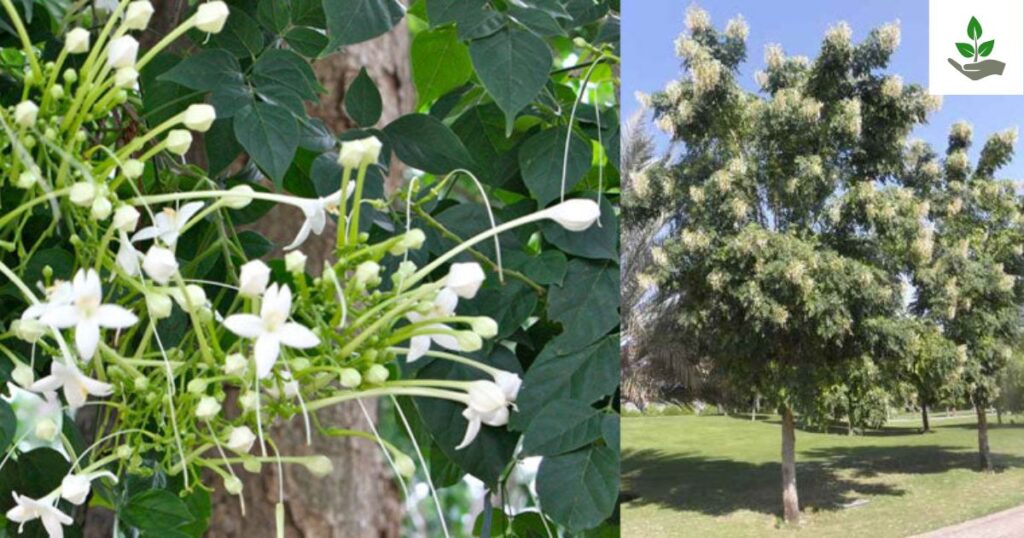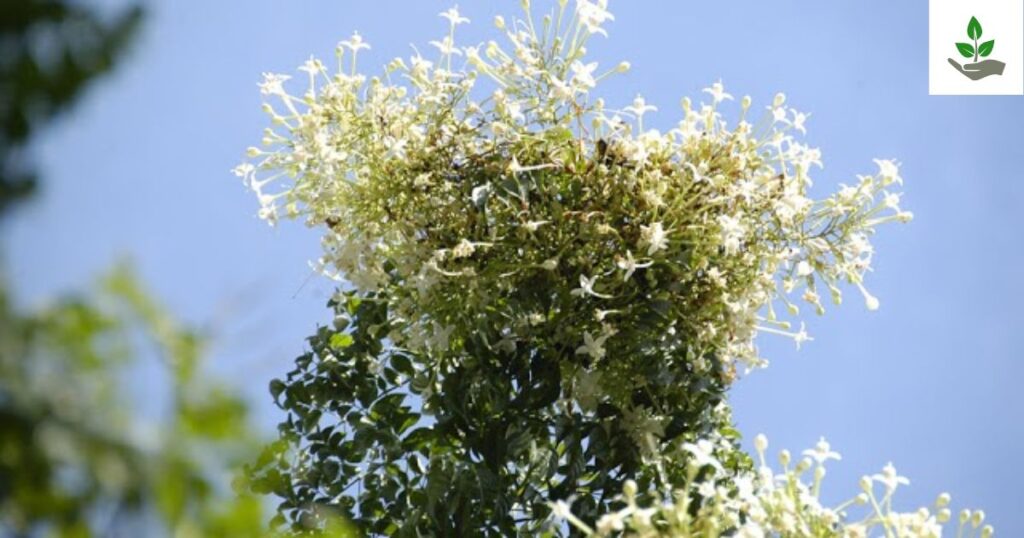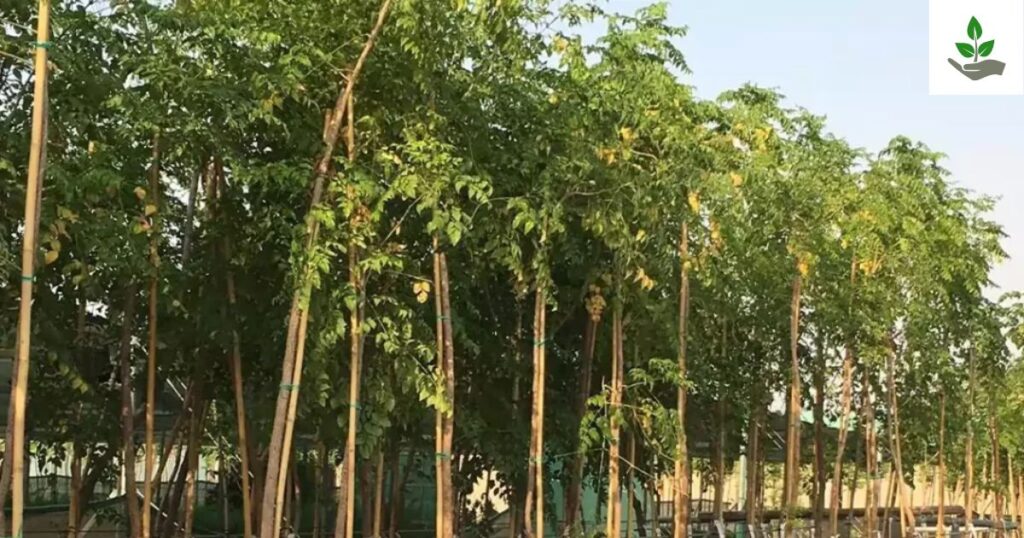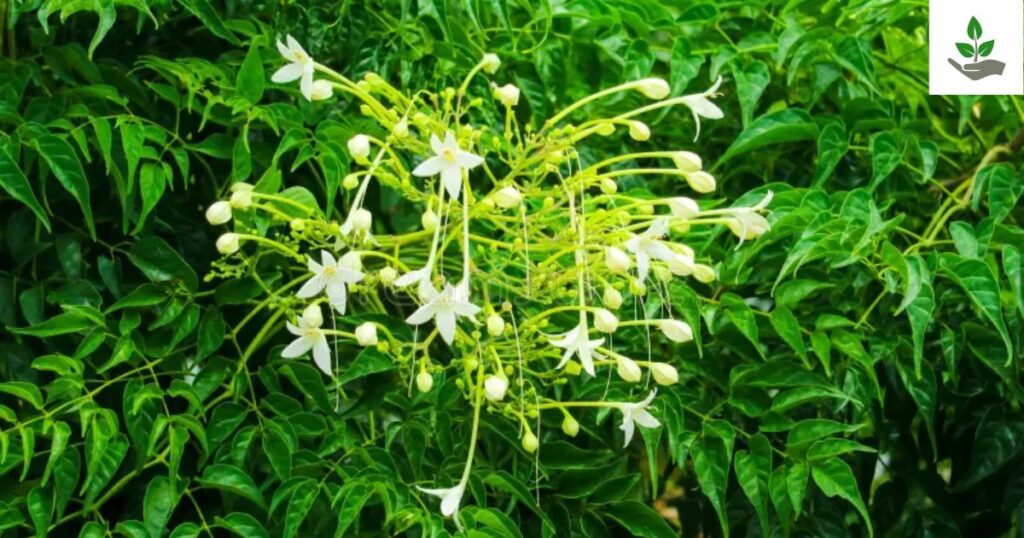Millingtonia Hortensis Care, History, Planting and Benefits
This Plant known as the Indian Cork Tree or Tree Jasmine, stands as one of South Asia’s most cherished ornamental trees. With its graceful stature reaching up to 80 feet and cascades of fragrant white flowers that perfume the night air, this evergreen member of the Bignoniaceae family has captivated gardeners and botanists alike for centuries.
Discover the Millingtonia Hortensis Care, effective planting techniques, and tips to ensure they thrive in your garden. By the end, you will have a comprehensive understanding of how to incorporate this beautiful tree into your outdoor space while reaping its numerous benefits.
What Is A Millingtonia Hortensis?
Millingtonia hortensis or Jasmine Tree or Indian Cork Tree is a big evergreen tree belonging to the Bignoniaceae family. It is native to the Myanmar-Thailand region. It grows to 80 feet in height with an erect growing corky trunk. Its most noticeable feature is the abundance of pendant groups of highly fragrant white flowers that bloom primarily in autumn and winter and fill the air with a nauseatingly sweet jasmine fragrance that’s particularly noticeable in the evenings.

It’s an ornamental and shade tree with pinnate leaflets of serrated shape that are evergreen, covering and ornamenting. Widely cultivated across South Asia for its appearance, scent, and medicine, Millingtonia hortensis is now a garden popular, street and park tree, across the subtropical and tropical world.
Millingtonia Hortensis History
Millingtonia hortensis has a rich history going back several centuries in Southeast and South Asia. Native to Burmese (Myanmar) and Thai forested regions, the scented tree was well-named after an English-born botanist, Thomas Millington, by “hortensis,” meaning that it must be cultivated as an ornamental tree in the garden.

By the 18th century, the British botanists had already found it and introduced it into official cultivation throughout colonial India, where it soon became widely known for its beauty and medicinal values. Being of great importance in ancient Indian culture, the tree was included in ancient Ayurvedic medicine for respiratory ailments and skin diseases.
Its tree bark that was similar to cork was more valuable than its weight in terms of native craftwork, and Buddhist monasteries usually planted it for the benefit of having unsoiled white-colored flowers which symbolize enlightenment. The modern world still adorns its streets and gardens of India, Sri Lanka, and most of Southeast Asia, bearing witness to centuries of plant and culture exchange.
Millingtonia Hortensis Planting
Milingtonia hortensis cultivation requires proper planning for optimal growth and flowering. It is a rapid-growing tree which prefers full sun and well-drained pH 6.0-7.5 soil but shows extensive tolerance to grow in other soils as well. Optimum planting period is early monsoon (June-July) in tropical regions, allowing young saplings to establish strong roots before flowering during winter.
In selecting a location to place it, provide a lot of space at least 20 feet from a structure to its ultimate height of 60-80 feet and medium width. Plant in a two-diameter-wide but same-depth hole, provide organic compost, and water thoroughly when planted.
Young trees benefit from a year’s staking and regular watering until established, then are extremely drought-resistant. Low maintenance requirements and resistance to all but the most pests and diseases make this tree reward gardeners with decades of its beautiful scenting flowers, if planted where evening breezes can waft its jasmine perfume throughout the garden.
Guide About Millingtonia Hortensis Care
Care for a Millingtonia hortensis tree is minimal and makes it an ideal choice for both novice and experienced gardeners. Mature, this robust tree should be watered infrequently, with the exception of extended droughts, as its deep root system easily dips into groundwater. Feed annually in early spring with an unbalanced, low-nitrogen fertilizer (10-10-10) to promote abundant flowers without excessive foliage growth.
Light pruning after the winter flowering period maintains it in its elegant shape and removes any dead or rubbing branches, otherwise the tree likes to grow into a lovely, upright shape with little structural modification. While quite pest-free, the tree should be inspected periodically for scale insects or leaf miners, particularly in hot, damp weather.

The tree’s drop flowers make a natural mulch beneath the canopy, preventing weeds and water evaporation. Its outstanding tolerance of city smog, aridity, and heterogeneous soils rewards Millingtonia hortensis its caretakers with decades of beautiful flower-scented flowers and twelve-months-a-year evergreen delight with surprisingly little involvement of maintenance.
What Are Millingtonia Hortensis Uses And Benefits?
The Millingtonia hortensis tree has an incredible array of uses and benefits aside from its own aesthetic appeal. Its strongly scented white flowers, which are packed with essential oils, are utilized to make perfumes and conventional garlands used in South Asian weddings. Its various parts have been utilized to treat respiratory conditions like asthma and bronchitis in Ayurvedic medicine.
Leaf extracts have exhibited impressive antimicrobial and anti-inflammatory activities in recent scientific studies. Its cork-like bark is utilized in handicraft and its extensive root system prevents landslides from occurring in brittle environments. In a biological aspect, the Indian Cork Tree is an excellent air cleaner and sink for carbon and absorbs urban poisons, casting cooling shade upon hot climatic temperatures.
They attract nocturnal pollinators and bees to flowers with rich nectar, which increases local biodiversity, while the closed canopy of the tree provides protection to many birds for nesting purposes. Among planners, drought resistance, relative low water use, and tolerability to air pollution make the tree an increasingly attractive sustainable option in roadside plantations and green infrastructure applications worldwide in the tropical and subtropical regions.
Millingtonia Hortensis Fun Fact
Millingtonia hortensis tree retains intriguing quirks that amaze botanists and gardeners alike. Described as the “Tree of Night Jasmine,” it displays an oddity called nyctanthous flowering to release its strongest scent at nighttime when its bell-shaped flowers yield a radiant luminescence by moonlight to entice dedicated night-flying moth pollinators with specialized proboscises perfectly adapted to access its profound nectaries.
Interestingly, a single mature tree can produce over 10,000 flowers in one flowering season with stunning “white carpets” forming beneath its canopy every morning when old flowers drop. The tree has natural bioluminescence in flowers that ancient Indian literature refers to as “stars fallen to earth” and therefore used in traditional evening festivals. Its bark holds a chemical compound named lapachol with anti-cancer properties reported to be researched by drug firms.

Perhaps most fascinating of all, however, is the tree’s “memory” of seasonal change—when planted in multiple hemispheres, Millingtonia trees will remain faithful to flowering according to their native home’s seasons for several years before acclimating to their new location’s climate cycle, demonstrating an amazing chronological botanical obstinacy that fascinates and bewilders horticultural scientists.
Read More Post: Butea Monosperma Care, History, planting and Benefits
Conclusion
The Millingtonia hortensis is the epitome of flower beauty, scent, and utility in the floral world. From its stately tallness adorned with delicate, jasmine-scented blooms to its medicinal properties and ecological benefits, the tree is in demand in gardens, road verges, and Ayurvedic medicine cabinets across South Asia and the globe.
While Millingtonia Hortensis Care is that much easier and low maintenance, the Indian Cork Tree rewards its cultivators bountifully in the shape of round-the-clock leaves, well-timed flower displays, and a whole array of practical uses. As cities are progressively finding the virtues of indigenous plant species that boost biodiversity and eco-friendly landscapes, the Millingtonia hortensis arrives as a vindication for the decision of embracing native plants into our environment.
FAQs
How do you propagate Millingtonia hortensis?
Millingtonia hortensis can be propagated through seeds, stem cuttings, or root suckers. Fresh seeds should be sown in well-drained soil for better germination. Cuttings require a humid environment and rooting hormone for success.
Can it be grown in pots or containers?
It is not ideal for pots long-term due to its size, but young plants can be started in containers before transplanting.
Is the tree suitable for urban planting?
Millingtonia hortensis is well-suited for urban planting due to its upright growth and minimal root disturbance. It provides shade, emits a pleasant fragrance, and enhances city landscapes. Its non-invasive roots make it safe for pavements and roadsides.
Is it fast-growing?
Yes, it grows rapidly, reaching heights of 15–25 meters, making it suitable for quick landscaping.
When does Millingtonia hortensis bloom?
Millingtonia hortensis typically blooms from late summer to early winter, especially between September and February. The tree produces fragrant, white, trumpet-shaped flowers. Blooming is often more profuse in cooler weather and early mornings.







